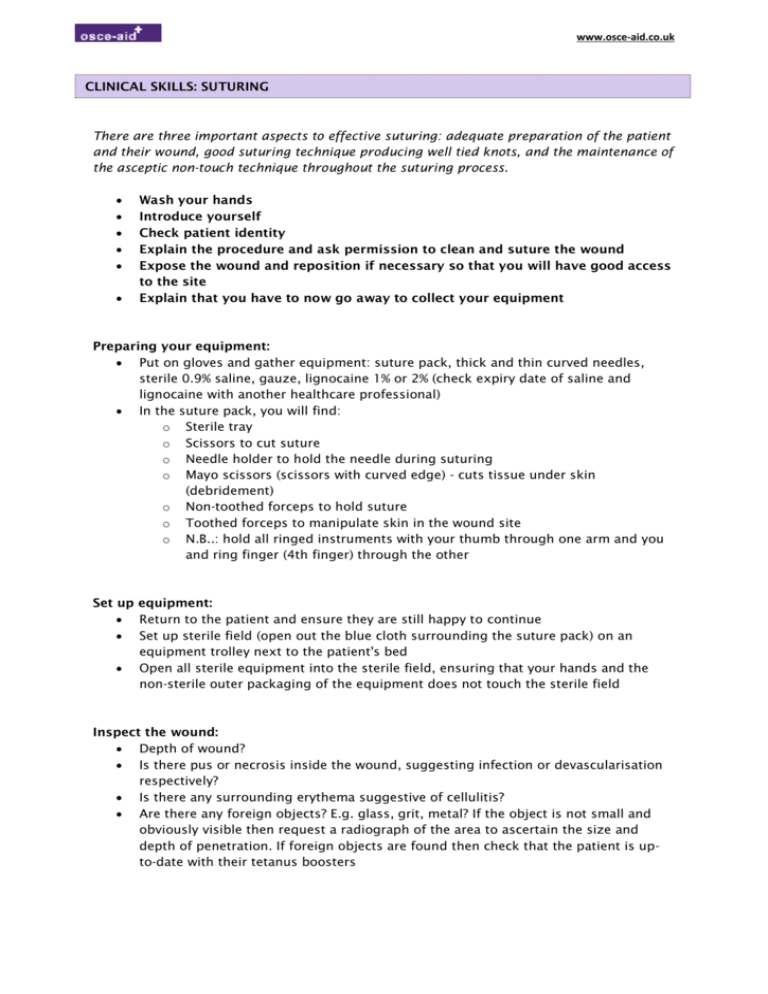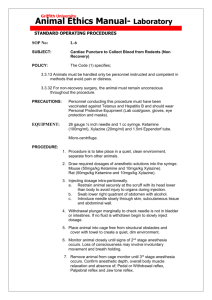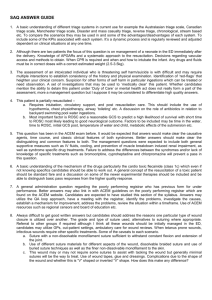osce_suturing - OSCE-Aid
advertisement

www.osce-aid.co.uk CLINICAL SKILLS: SUTURING There are three important aspects to effective suturing: adequate preparation of the patient and their wound, good suturing technique producing well tied knots, and the maintenance of the asceptic non-touch technique throughout the suturing process. Wash your hands Introduce yourself Check patient identity Explain the procedure and ask permission to clean and suture the wound Expose the wound and reposition if necessary so that you will have good access to the site Explain that you have to now go away to collect your equipment Preparing your equipment: Put on gloves and gather equipment: suture pack, thick and thin curved needles, sterile 0.9% saline, gauze, lignocaine 1% or 2% (check expiry date of saline and lignocaine with another healthcare professional) In the suture pack, you will find: o Sterile tray o Scissors to cut suture o Needle holder to hold the needle during suturing o Mayo scissors (scissors with curved edge) - cuts tissue under skin (debridement) o Non-toothed forceps to hold suture o Toothed forceps to manipulate skin in the wound site o N.B..: hold all ringed instruments with your thumb through one arm and you and ring finger (4th finger) through the other Set up equipment: Return to the patient and ensure they are still happy to continue Set up sterile field (open out the blue cloth surrounding the suture pack) on an equipment trolley next to the patient's bed Open all sterile equipment into the sterile field, ensuring that your hands and the non-sterile outer packaging of the equipment does not touch the sterile field Inspect the wound: Depth of wound? Is there pus or necrosis inside the wound, suggesting infection or devascularisation respectively? Is there any surrounding erythema suggestive of cellulitis? Are there any foreign objects? E.g. glass, grit, metal? If the object is not small and obviously visible then request a radiograph of the area to ascertain the size and depth of penetration. If foreign objects are found then check that the patient is upto-date with their tetanus boosters www.osce-aid.co.uk Clean the wound: Different methods can be used. These include: o Using sterile 0.9% saline to soak gauze and carefully wipe area – most commonly used o Betadine or chlorhexadine with gauze - may be necessary if the wound recieved exposure to unhygienic materials o 0.9% saline irrigation if the wound had heavy visible soiling - this is when a significant volume of saline is used to run over the wound o If required can be debrided with 'Mayo scissors', especially if there is clear sign of devascularisation of the wound or significant infection. Speak to your senior if you are not clear on the indications or methods for debriding a wound Apply local anaesthetic: Ask the patient about allergies before you insert anaesthetic. If they had previously reacted to a local anaesthetic with paraesthesia, convulsions, anxiety or cardiac arrythmias then avoid the local anaesthetic The maximum dose of lignocaine that can be administered to a patient is 3mg per kg of weight o So for a 70kg patient, the maximum dose would equal 70 x 3mg = 210mg lignocaine in 30-40 minutes (it lasts 30-40 minutes) o 100% lignocaine would contain 1gram of lignocaine per 1ml of solution o If lignocaine is 1%, then there is 10mg in 1ml of solution o So, a 70kg patient would be able to receive 21mls of solution How to administer the local anaesthetic: Check the name, strength and expiry date of the drug with another healthcare professional Attach a thick green needle to syringe and fill with the appropriate amount of lignocaine Remove thick green needle and attach thin orange needle to the syringe Insert needle into the skin around the wound area so that it penetrates into the dermal layer First pull back on the syringe to ensure that you haven't penetrated a blood vessel (you will see blood returning into the syringe if you are in a blood vessel). If you penetrated blood vessel then pull the needle out and apply pressure to the area until the bleeding stops If you are confident that you are in connective tissue then push the syringe slowly whilst slowly drawing the needle and syringe out of the skin, to 'infiltrate' the local anaesthetic into the area. Do this at various points around the wound Wait 5 minutes until the area is anaesthetised (check with the patient whether they can feel a sharp sensation) Suturing: Change your gloves Open the suture pack Try to reposition the patient so that the wound lying horizontally and across lengthways in front of you Put needle in needle holder. To do this, hold the needle holder in your dominant hand, and clamp the end of the needle holder onto the needle, about 2/3rds of the way along the needle, with the end of the needle pointing down www.osce-aid.co.uk Use toothed forceps in your non-dominant hand to hold open wound. Hold the forceps like a pen. Start by grasping and pulling up the skin on the far side of the wound Penetrate the skin about half a centimetre away from wound with needle Pronate wrist to rotate the needle and bring the tip of the needle out into the wound, about half a centremetre deep to the surface of the skin Unclamp the needle holder from the needle Use non-toothed forceps in your non-dominant hand to pull needle through Regrasp the needle with the needle holder as before Pentrate into the inside (ie the dermis) of the wound about half a centimetre deep to the skin Again, pronate your wrist to rotate the needle out of the skin layer, aiming to penetrate out of the skin about half a centimetre from the wound site To instrument tie the suture: o Put needle down in safe place, not directly onto the patient o Pull the suture further through the wound until leaving approximately 2-3cm sticking out from the skin o Hold needle holder parallel to and directly above the suture o Using hand, wind the longer (closer) piece of suture around the needle holder twice loosely o Then, with two loops of the suture loosely wrapped around the needle holder, clasp the short (ie far) end of the suture string with the grips of the needle holder o Pull needle holder towards the tail (from 12 o'clock to 6 o'clock) o Now the tail should be at 6 o'clock o Repeat twice more, but each time only winding the long piece of suture once around the needle holder o Dispose of needle in sharps bin once finished Don't forget: o Make sure you pull the first knot tight o The final suture should be 1 cm in length (half a centimentre from either side of the wound o Each new suture should be 1 cm away from each other Advise the patient: On how long to keep the sutures in for (5-7 days, unless dissolvable sutures are used) To keep area covered with a dry dressing, and to avoid getting the dressing wet whilst it is on Advise them to seek medical infection if there are any signs of wiound infection - e.g. increased pain, redness, swelling, or if they experience fevers Thank the patient and provide with leaflet on wound care of sutured wounds





